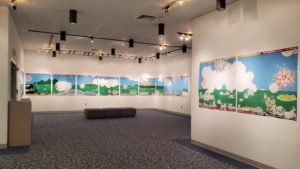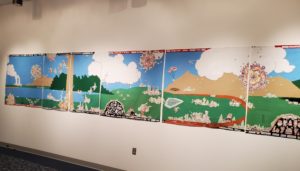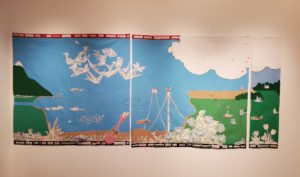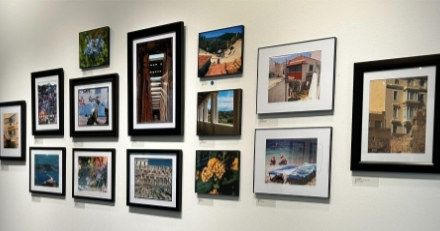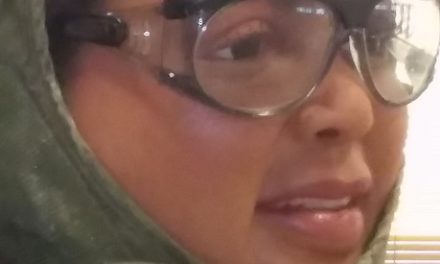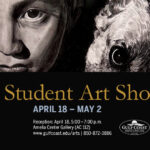The Amelia Center Gallery is a hot spot for people to gather and view different featured artworks every month. For early March, Vantage Point, a 111-foot hand-stitched textile embroidery, was displayed there. The artist, Maggy Rozycki Hiltner, described the process and inspiration behind her piece during an artist lecture and demonstration on February 28th. Hiltner explains in her artist statement that Vantage Point’s conception started after she was selected to create an installation for one of the Mesa Contemporary Arts Museum’s project rooms in April of 2014.
INSPIRATION BEHIND VANTAGE POINT
“I began by designing an idealized landscape with a big blue sky, green grass, and puffy white clouds. Researching ways of depicting cloud forms led me to thinking about clouds as water vapor and then water vapor as greenhouse gas. Other clouds—volcanic plumes, mushroom clouds, emissions from factories and puffs rising from the cooling towers of nuclear reactors—drew my attention as well.”
Hiltner goes on to explain her experiences while growing up; being raised in Pennsylvania, industrial waste was all too common.
“The more I researched, the more I knew I had to include pollution, both seen and unseen, from my personal landscape.”
Maggy Hiltner grew up within a 10-mile evacuation radius of a nuclear power plant in Pottstown that she could view from her middle school classroom window. She continued to give more examples from her childhood experiences of growing up in such a hotspot of pollution. And as she did, it becomes clear that this is where the inspiration of Vantage Point originated. Hiltner incorporated stitching of natural and manmade disasters into the landscape as her research continued. As she added to her embroidery, Hiltner also created a glossary of key terms from headlines and new stories. These key terms and text later became a display guide for Vantage Point‘s scenes.
“Maps and illustrations drew me to include portolan lines and vanishing points—adding movement and a linear design element and poking fun at my tendency towards flat representation… The world I made is still beautiful, but the impact of human consumption and waste is everywhere.”
About The Author
Maggie Spring
Student - Spring 2020

